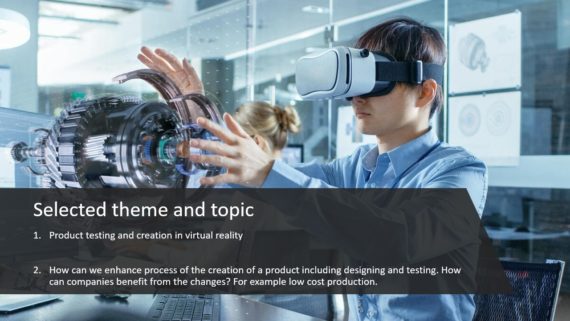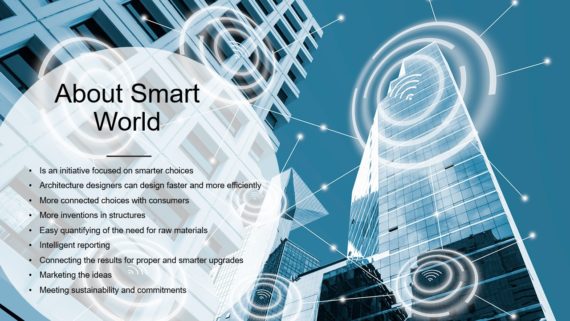The second workshop day was held on the 13th of October 2021, from 9:30 to 14:30. A total of 24 student participants gathered in Microsoft Teams for the day. Students working in the teams were present since the morning and other participants were invited to join for the Futures Fair in the afternoon. In the Futures Fair, each team was to present their work from the workshop days’ group working sessions.
Similarly, to Workshop Day I, the second day started with an introduction to the day’s agenda. Workshop manager Tero Villman gave a recap on the work done so far and reminded the teams of the workflow. In the last groupwork part, the teams had to gather their earlier ideas with the most votes from the foresight lense. One idea from each dimension in PESTE was chosen to work on further.
The next phase was to draft a future scenario. A scenario is a potential image of the future set in a specific time with a logical path leading to or from it. In this case, the scenario was to be from the year 2030. The teams had to write down how their ideas would look in the future versus the current moment. It was also important for each team to give their scenario a catchy and intriguing name. The topic’s relation to competence development, new technologies, and opportunities for cross-border collaboration was underlined so that each team would remember to take these overall themes into account in their scenario.
The teams listed the changes that would need to occur in 2022, 2025 and 2028 for their scenario to come true in 2030. This formed a narrative, a logical path from the current moment to the team’s envisioned future. The teams were allowed to find and use images in their work. These scenarios were presented at the Futures Fair at 12:30.
The Futures Fair
Team 1: Meaningful work augmented by technology in 2030
Scenario: Future Hospital
The team’s most important themes were VR in healthcare and teaching, and AI & robots in healthcare. Some of the team’s ideas were about how artificial intelligence could assist in diagnosing patients, automatization of databases and efficient communication within the hospital. Robots could help with patient care and in manual labor and as an entertainment service to patients. The teams also presented ideas concerning prosthetics and augmentation and how they would be developed in the far future.
Team 2: Product testing and creation in virtual reality
Scenario: The juicy future of VR designing
The team pondered the juicy future of VR design – virtual reality for customers & business. How can we enhance the process of the creation of a product including designing and testing? How can companies benefit from these changes, such as lowering the cost of production? The steps into this scenario in 2030 would include VR technologies becoming more common in different environments for businesses and customers to take advantage from them. To use VR in prototyping, the technology would also have to become more advanced and easily accessible.

Team 3: Meaningful work augmented by technology in 2030: How technology can enhance the learning process in the medical field
Scenario: Virtual push
For the team’s scenario to happen in 2030, the usage of virtual reality technologies would have to become more commonplace. New technologies would be introduced into the learning process and studies would include more engagement via visuals and audio virtually. As these technologies become more common, more opportunities arise: education and possibilities to learn become more accessible and equality increases globally. This scenario has downsides, too: the continuously increasing consumption of electronics will have a negative impact on the environment and the increased number of professionals will lead to unemployment.
Team 4: Life-long learning on the job in 2030
Scenario: Almost positive
The team’s topic was the potential of lifelong learning in helping individuals to learn anywhere with less effort. In the digital age, the application of technologies to businesses will be a better virtue than simply knowing the technology itself. Blended learning can give different learners the opportunity to learn based on their personal preferences and style at their own convenience. This will also promote continuous lifelong learning. In this scenario, re-skilling and repurposing one’s talents is important. For the learner, lifelong learning is often voluntary and stems from self-motivation. It is important to have opportunities for up-skilling, re-training, and professional development to stay relevant and progress in working life.
In the scenario, in 2030 the technological advances are embraced by everyone, giving access to the tools and the possibility for lifelong learning. This will open cross-border collaboration. There can also be negative impacts in this scenario, such as the need for specialists in mental health care and social issues to deal with the negative consequences of alternate reality (AR).
Team 5: Smarter architecture with VR
Scenario: Smart World
The smart world scenario is all about focusing on smarter choices. Architecture designers can design faster and more efficiently and make more connected choices with the consumers. Structures will have more inventions, such as intelligent reporting and connecting the results for better and smarted upgrades. Sustainability is an important theme to back the scenario up.
Virtual reality along with research and development is deployed for better solutions, continuous improvements and making sure the consumer’s choices and needs are considered. Eventually the smart world way of thinking is realized as the main way to design and construct buildings. The new designs will have zero emissions.

Conclusions
After the presentations, everyone had the opportunity to discuss and ask questions from the teams. Many of the teams’ presentations had common themes. The scenarios aim mainly to improve our quality of life and unite us across the world. For these benefits to happen we must also be ready to accept new technologies. AR and VR seem to enable solutions to many issues, but their negative impacts were also present in the scenarios.
As common nominators for every team’s conclusions one could raise the unprecedented opportunities of AR and VR in enhancing an individual’s personal aspirations both during one’s educational path and their capabilities in influencing the development of the surrounding society.
The teams gained positive feedback from the audience and from each other. For such a short time to prepare, each team did an impressive job. Successful group working was in a key role in the work process.
After the workshop days, each team’s facilitator will make sure the outputs and the work are documented into a report.
Read more about the series of Futures Lab Workshop: https://www.xamk.fi/en/events/race4scale-future-workshop/
